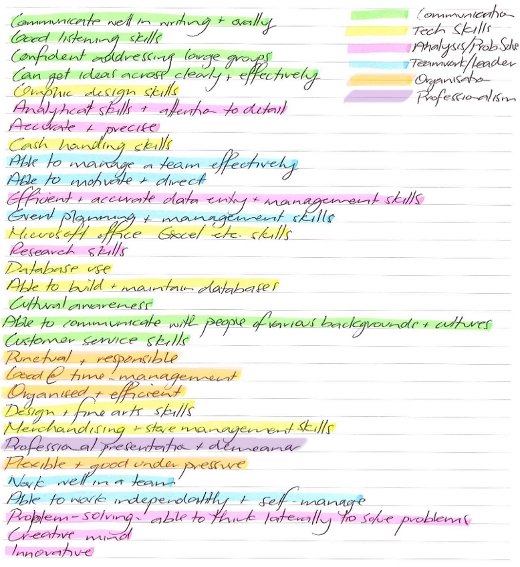Target your skills to the job you're applying for and give yourself the best chance possible of getting an interview. Before you start drafting this section, read through pages 8-10 of our CV Information book.
Download the CV Information book (PDF, 264KB), or pop in and pick one up from the Career Development Centre.
What skills employers want
Every employer is different, but luckily for us, they usually tell us what skills they're after in the job description, advertisement or other media.
To put together an effective skills section, you need to take the information about yourself you organised for the skills category, and match it up with the employer's needs.
Divide up your list of skills
Grab your highlighters and use different colours to group similar skills together - for example, you could highlight all the skills and attributes that have something to do with communication one colour, then everything to do with time management and organisation another colour and so on.

At the bottom of this page, make a note of how many different colours you used, and have a go at giving each colour a title e.g., Green=Communication, Pink=Research and Analysis. Your CV Guide will come in handy here - check out pages 8-10 for some title ideas.
- Rearrange the skills in your list into groups of the same colour
- Using pages 8-10 your CV Information book for ideas, give each group (or 'skillset') a category name
Take a closer look at the job description
Grab your highlighters and read through the job description - you'll find a hidden list of skills and attributes to highlight. Use a different colour for each, and see if you can match the colours with those of your highlighted skills list.
View example showing matching of skills with job description (PDF, 783KB)
You'll probably find that once you've puzzled out what the employer is after, you want to add more skills you've thought of or group your skills differently - go ahead! This just means you're responding to the employer and deciding on the content of your CV based on their needs - perfect!
Present your skill-sets in order of importance to the employer
The key to an effective skills section is to present the skill-sets you identified in your list in order of their importance to the employer.
People naturally prioritise what's most important to them (ie, put what's most important first and what's least important last). So, your prospective employer's 'hidden list' will probably start with what they value most and go from there. You can also use your own knowledge of the industry or field you're entering to prioritise you skills list.
Order your skills section according to the employer's priorities, not according to your own views or strengths.
Provide evidence for your claims
Now we've got a basic list of your skills arranged into 'skillsets', but pointing out that you've got a skill isn't enough - you need to prove it.
For each skill in your skillsets, write a sentence expressing what the skill is, and where you used it well or developed it further.
- Use the lists of active verbs on pages 11 and 12 of your CV Information book to help you write effective sentences for each skill
- Remember to apply the rules of hierarchy here too - put the most important thing (what the skill is) first, then back yourself up with evidence from previous positions, your education (degree course), or even daily life
- Keep your language formal, but enthusiastic, friendly and energetic
For example:
I excelled in the role of team leader when given the opportunity in my previous positions at ____ and ____.
The sentence above packs a lot of info into a very small space - from this we can tell not only that the applicant is a good team leader, but also that he/she:
- was trusted and valued by previous employers (because they made him/her a team leader)
- has a desire to advance and thrives when presented with a challenge (because they accepted the opportunity when it was presented and is proud of their achievements)
- really did excel at it, because they were offered this opportunity more than once and in 2 different positions
All that, and the employer only has to read one sentence!
Integrate your skills section into your CV layout and style
Now work your skills section in to your CV's established style and layout. Bullet points are the most effective way to present the individual skills in each skillset, and each skillset needs a subtitle.
Read the 'Responding to Skills Criteria' section of our CV book for some subtitle and skills category ideas.
Next step...
In the next stage, build up your Work History section...
Previous – Step 5: List your qualifications
Next – Step 7: Present your work history